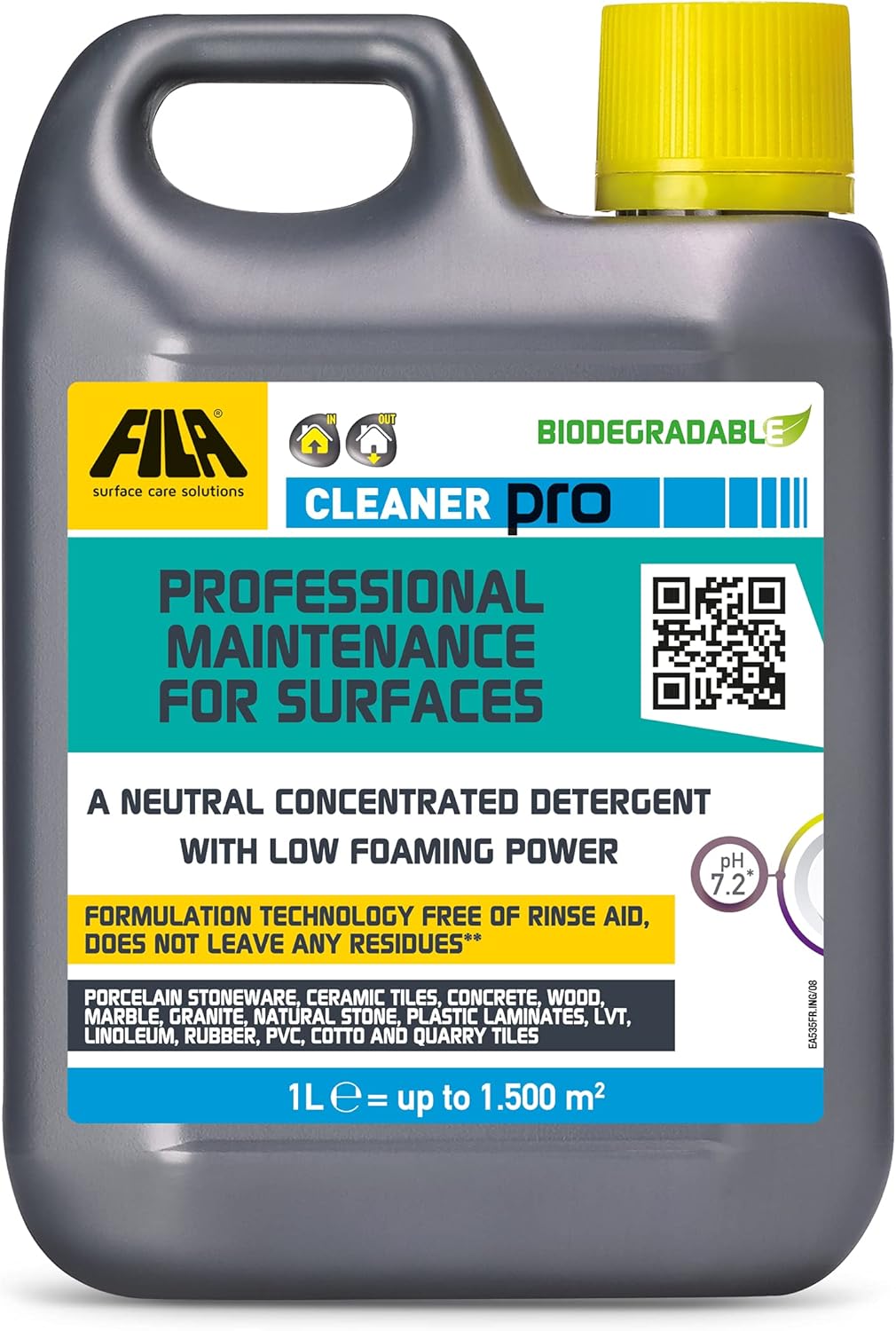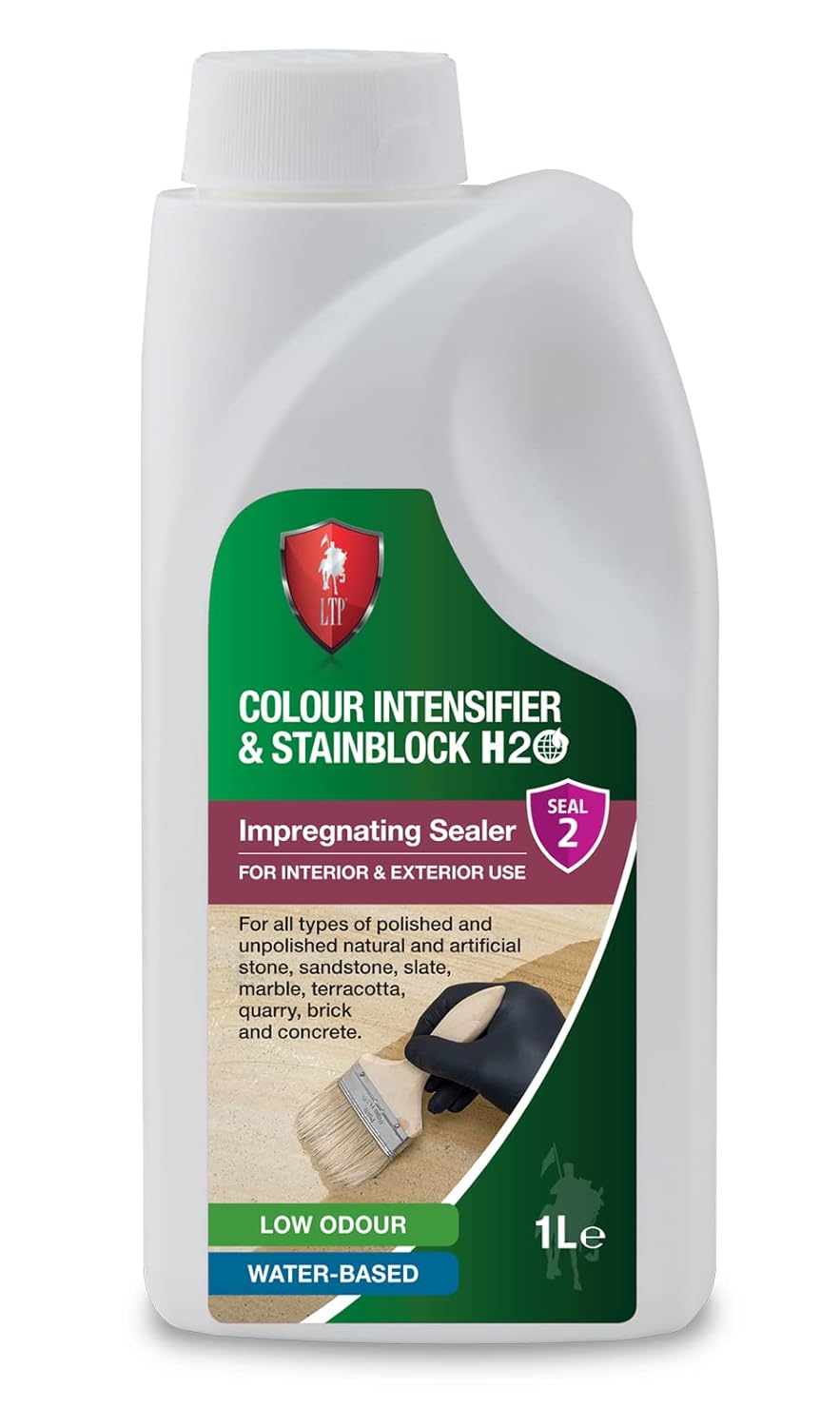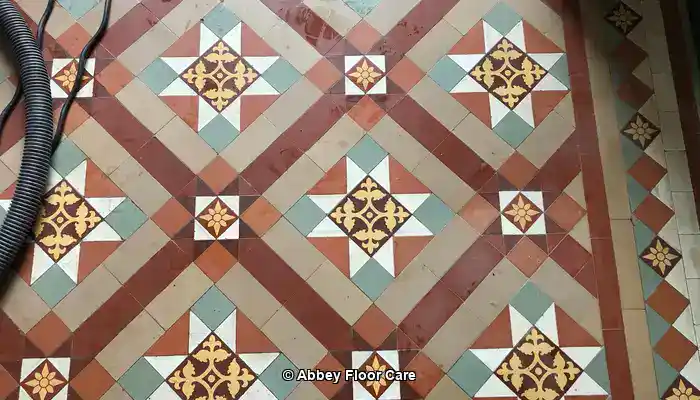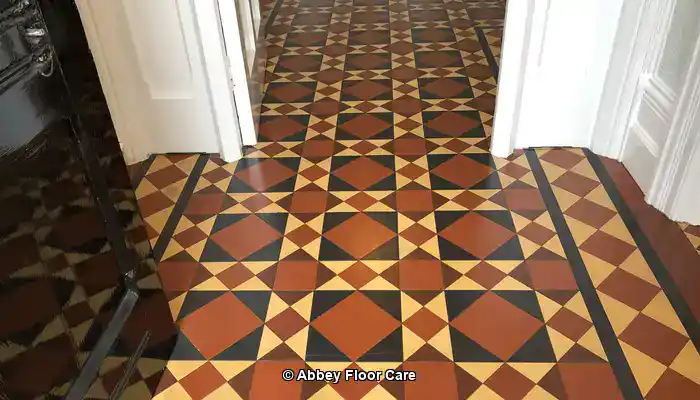
Last Updated on October 30, 2025 by David
Proven Strategies for Reviving the Original Colour and Pigment of Faded Victorian Mosaic Tiles
- Victorian mosaic tiles frequently suffer from colour loss due to accumulated dirt, outdated protective coatings, and general wear over time, rather than simply because of their age.
- Aggressive cleaning chemicals and excessive scrubbing can severely strip original pigments, particularly on encaustic and geometric tiles, leading to irreversible damage and loss of aesthetic value.
- Safe restoration starts with a thorough cleaning process that utilises pH-neutral solutions, paired with low-speed rotary machines equipped with soft brushes to ensure the tile surface remains protected.
- Meticulously removing old sealers and waxes is essential to exposing the true condition of the tiles underneath, allowing for a more effective restoration.
- Enhancing colour can be achieved through the application of breathable, stone-safe sealers that enrich the tile’s tone without leaving behind a shiny or glossy finish.
- Professional restoration can rejuvenate original pigments without the need for repainting or artificial colours, thereby maintaining the authenticity and historical integrity of the tiles.
- Care for restored tiles involves gentle cleaning routines and avoiding harsh acidic or bleach-based products that may cause irreversible damage to the tile surfaces.
- Heritage-sensitive restoration methods ensure that both the aesthetic and historical integrity of the tiles are preserved, allowing them to be appreciated for years to come.
Understanding the Significance of Restoring Victorian Tiles

Abbey Floor Care restoring the colour to a Victorian clay tile floor using a colour-enhancing impregnating sealer.
Victorian encaustic and mosaic tiles are a vital component of British architectural heritage, celebrated for their intricate craftsmanship and unique colour palettes derived from mineral pigments embedded directly into the clay tile bodies. These tiles not only elevate the aesthetic appeal of buildings but also serve as a testament to the historical artistry of the Victorian era. However, as time progresses, these exquisite tiles can lose their visual vibrancy due to factors such as surface wear, exposure to harsh chemicals, and environmental conditions. The restoration process requires specialised knowledge, a deep understanding of the materials involved, historically accurate techniques, and the use of high-quality products that respect and honour their heritage.
Pro Tip: Recommended Products for Daily Maintenance of Victorian Tiles

Fila Pro Floor Cleaner
|

LTP Colour Intensifier & Stainblock H20
|

Vileda H2PrO Spin Mop System
|
Over time, these tiles can lose their visual appeal due to surface wear, chemical exposure, and environmental factors. Restoring their original vibrancy is a specialised task that requires extensive knowledge of the materials, historically accurate techniques, and the use of premium products. This comprehensive understanding is vital to ensure that restoration methods honour both the aesthetic qualities and the structural integrity of these historic tiles, thus preserving their beauty for future generations to appreciate and enjoy.
Identifying the Causes of Fading in Victorian Mosaic Tiles

Example of Victorian Clay Tile Floor dulled through surface wear and damage.
While the inherent pigments are a crucial aspect of the tile’s appeal, several factors contribute to the fading and dulling of these beautiful surfaces:
- Accumulation of dirt and grime: Over time, foot traffic leads to the buildup of fine particles and oils that penetrate porous surfaces, scattering light and causing colours to appear dull. This accumulation significantly diminishes the vibrant appearance of the tiles, rendering them lifeless and uninviting.
- Wax and polish buildup: Layers of wax or sealants that lack breathability trap moisture, resulting in a cloudy or yellowed appearance. This not only detracts from the visual quality but also poses a risk for further degradation of the tile surface.
- Moisture-related issues: Many Victorian tiles were installed on subfloors without damp-proof membranes, leading to rising damp that brings soluble salts to the surface. These salts can crystallise, resulting in efflorescence that obscures the original tones. Addressing this issue promptly is crucial to prevent significant long-term damage.
- Physical wear: Small scratches accumulated over years of use disrupt the smooth reflection of light, diminishing the overall visual richness of the tiles. Over time, these minor abrasions can accumulate, leading to a substantial loss of the tiles’ aesthetic appeal.
Effective restoration meticulously addresses each of these factors without compromising the tile’s historical composition. This requires a systematic approach that resolves all underlying issues, allowing the tiles to regain their former glory and vibrancy.
The Critical Role of Breathability in Restoration for Tiles Lacking Damp-Proof Membranes
Given that many Victorian tiled floors are situated on older subfloors that lack damp-proof membranes (DPM), it is vital for the natural clay structure to remain permeable to allow moisture from the subfloor to evaporate. Non-breathable wax coatings or film-forming sealers obstruct this critical pathway for evaporation, leading to moisture build-up beneath the surface. This entrapment can result in the formation of salts and humidity, causing efflorescence, degradation of surface minerals, and the undesirable phenomenon known as wax blooming, which appears as a whitish film on the tile. Restoration plans must prioritise breathable impregnating sealers that protect the tiles while allowing moisture vapour to escape, thus preventing long-term damage and ensuring the tiles’ integrity and longevity.
A Thorough Investigation of Pigments and Tile Composition

An example of different pigments in a Victorian Clay tile floor during restoration by Abbey Floor Care
Delving into Mineral Oxide Pigments Found in Victorian Tiles
Victorian mosaic and encaustic tiles derive their unique earthy colours from mineral oxide pigments that are embedded directly within the clay. These pigments not only enhance the durability of the tiles but also enrich the colours with depth and complexity. The primary pigments include:
- Iron oxide: responsible for producing terracotta reds, rust browns, and soft ochres, contributing to the warm tones that define many Victorian designs.
- Manganese: generates deep browns and rich blacks, enhancing visual contrast within intricate mosaic patterns.
- Cobalt: imparts a variety of blue hues, providing a lively touch to tile compositions.
- Chromium: creates natural green shades, broadening the spectrum of colours available.
Understanding the Firing and Fusion Process of Victorian Tiles
During the production process, tiles are fired at temperatures around 1100°C, which vitrifies the clay and fuses the pigments deeply into the body of the tile. This process ensures that the colour permeates throughout the tile, rather than merely resting on the surface, resulting in long-lasting vibrancy. The firing process is crucial for maintaining the durability of the colours, effectively preventing fading or loss of pigment over time.
Examining the Porous Unglazed Finish of Victorian Tiles
Victorian tiles typically feature a porous, unglazed matte finish, contributing to their natural appearance. However, this porosity makes the tiles absorbent and sensitive to surface contamination and moisture, necessitating careful cleaning and maintenance. While this characteristic allows the natural beauty of the tiles to shine through, it also requires a more diligent approach to their care to ensure their longevity and appeal.
Understanding Variability in Colour Durability Among Victorian Tiles
Natural earth pigments, particularly in red and yellow tiles, contain fewer mineral additives compared to darker colours like black, which are formulated with manganese. This distinction leads to red and yellow tiles being less durable and more susceptible to surface wear under heavy foot traffic. This wear can manifest as shallow depressions in areas with concentrated foot traffic, resulting in uneven colour intensity and a loss of surface flatness. Recognising these differences is critical for developing effective restoration strategies that cater to the specific needs of each tile type.
Key Considerations for Achieving Successful Restoration
A thorough understanding of pigment composition and tile wear patterns is essential when planning restoration efforts. Softer-toned tiles require gentler cleaning methods and specially formulated impregnating sealers that respect their physical properties while enhancing colour vibrancy. Conversely, darker, harder tiles can withstand more intensive cleaning but still need breathable, colour-enhancing protection to maintain their vibrancy over time. This knowledge ensures the preservation of the tiles’ authenticity while revitalising their aesthetic appeal.
Expert Cleaning Techniques for Victorian Mosaic Tiles
Thorough cleaning is fundamental to restoring Victorian encaustic and mosaic tiles to their original brilliance. However, cleaning these tiles demands a specialised approach that goes beyond the use of basic pH-neutral detergents. Professional restorers utilise carefully formulated alkaline cleaners and mechanical techniques to dissolve heavy soiling and old residues without compromising the integrity of the historic tile fabric. This meticulous cleaning process lays the groundwork for a successful restoration.
Initial Removal of Debris from Tile Surfaces
The cleaning process begins with the careful removal of all loose dirt and grit using soft brushes or a vacuum cleaner equipped with brush attachments. This initial step is crucial to prevent scratches on the delicate tile surfaces during subsequent cleaning phases. By preparing the surface in this meticulous manner, restorers can effectively safeguard the integrity of the tiles and create the optimal conditions for deeper cleaning procedures.
Employing Alkaline Cleaners for Intensive Soil Removal
Unlike pH-neutral cleaners, which often lack the chemical strength to effectively combat ingrained fatty acids and organic residues, alkaline cleaners are essential for thoroughly breaking down household oils, grease, and sticky residues commonly found on tile surfaces and within grout lines. These alkaline formulations effectively dissolve the binding agents of dirt, sugars, and fats, allowing for their efficient removal while remaining compatible with the mineral composition of Victorian tiles. Typically, professional-grade alkaline products, such as <em>PS87 PRO</em> or custom formulations from heritage cleaning specialists, are employed in a diluted manner, ensuring deep cleaning without excessive aggression to the clay body, thus preserving the tiles’ original integrity.
Mechanical Agitation Using Suitable Cleaning Pads
Mechanical action significantly enhances cleaning effectiveness. Low-speed rotary scrubbers equipped with red or, in some cases, green non-abrasive pads are commonly used to agitate soils out of small pits, tile surfaces, and grout lines. These pads clean thoroughly while safeguarding the integrity of tile edges and delicate surface details. This method guarantees a comprehensive cleaning process while maintaining the unique characteristics of each tile, ensuring a successful restoration.
Removal of Old Waxes and Inappropriate Sealants
Years of use often result in the accumulation of old waxes and sealants, particularly from DIY attempts using unsuitable products. Water-based cleaners—whether alkaline or mildly acidic—are preferred for effectively removing these residues without damaging the tile’s mineral structure. However, stubborn ‘exotic’ or solvent-resistant coatings require targeted solvent-based removers such as Lithofin Wax-Off or LTP Solvex. These solvents can effectively soften and emulsify waxes and old sealants but must be handled with care by professionals trained in their safe application and disposal. This cautious approach ensures that the tiles are adequately prepared for subsequent stages of the restoration process.
Comprehensive Rinsing and Drying of Tile Surfaces
Following chemical cleaning, thorough rinsing is essential to remove all cleaning residues. Multiple rinses with clean water, combined with wet vacuum extraction, ensure that no detergent or solvent traces remain that could interfere with subsequent restoration coatings. The drying time varies depending on environmental conditions such as humidity, surface type, and moisture content. Restoration experts consistently utilise moisture meters to confirm that the tiles are fully dry before applying any impregnating sealers or protective treatments. This meticulous approach prevents moisture entrapment, which could otherwise lead to efflorescence, staining, or damage beneath sealed layers. Proper drying is crucial for the overall success of the restoration.
The Critical Importance of Thorough Cleaning for Restoration Success
A comprehensive cleaning process reveals the actual condition of the tiles by eliminating any visual obstructions. It exposes areas that may require repair and prepares a clean, receptive surface for colour-enhancing impregnators or other restorative products. This careful preparation is fundamental to the success and longevity of Victorian mosaic tile restoration. By ensuring that the tiles are entirely cleaned and ready for restoration, the likelihood of achieving optimal results is significantly enhanced.
Enhancing Colour Using Premium Impregnating Sealers
Restoration professionals utilise impregnating colour-enhancing sealers from reputable brands like <a href="https://amzn.to/40G0qka">LTP</a> and Lithofin, which are renowned for their advanced, heritage-approved formulations. Unlike superficial coatings, these sealers:
- Penetrate deeply into tile pores to physically enrich colour by altering light refraction.
- Maintain vapour permeability, which is essential for moisture escape, particularly critical in older floors lacking DPM layers.
- Provide durable protection against stains and foot traffic without altering the natural texture or gloss of the tiles.
- Are applied in multiple light coats, with each coat allowed to penetrate before the next is applied, ensuring complete uniformity across the surface.
These sealers directly combat fading by restoring vibrancy while preserving the historic floor’s breathable nature, ensuring that the restoration is both effective and respectful of the original characteristics of the tiles.
Repairing Damaged Tiles and Achieving Accurate Colour Tinting
Tiles with chips, cracks, or missing sections require careful repair using tinted epoxy or lime-based mortars that are colour-matched with natural mineral oxides. Restoration experts source matching replacement tiles from salvage archives to ensure continuity in pattern and design. Colour tinting involves the selective application of earth-pigment-infused wax or resin mixtures to seamlessly blend worn or missing pattern areas while respecting tile breathability and reversibility. This approach is essential for safeguarding the historical integrity of the tile design and ensuring that repairs are unobtrusive.
Best Practices in the Colour Tinting Process
- Utilise small, controlled applications to prevent overt colouring, ensuring that the final appearance remains authentic and true to the original.
- Conduct patch testing on inconspicuous areas before full application to confirm compatibility and effectiveness of the materials used.
- Ensure compatibility with the impregnating sealers that will be applied to the entire surface to maintain a cohesive finish across the restored tiles.
Vital Maintenance Practices for Restored Victorian Mosaic Floors
Maintaining the restored colour and condition of Victorian mosaic tiles necessitates ongoing care:
- Regular cleaning using pH-neutral, non-abrasive detergents specifically formulated for historic tiles to prevent damage and degradation.
- Implement preventive measures, such as placing entrance mats to minimise dirt ingress and protect the surfaces from wear.
- Promptly clean up liquid spills, particularly acidic substances like vinegar or wine, to avert surface etching and damage.
- Reapply breathable impregnating sealers every 3–5 years or as needed based on wear to ensure continued protection and vibrancy.
- Monitor floors for signs of efflorescence or moisture ingress that may indicate underlying damp issues, addressing them swiftly to prevent further complications.
Identifying and Avoiding Common Pitfalls in Tile Restoration and Maintenance
- Avoid wax treatments that can obstruct breathability and lead to issues such as efflorescence or wax blooming, which can significantly detract from the tiles’ overall appearance.
- Steer clear of acrylic or polyurethane sealants that trap moisture and cause degradation of the tile materials, undermining their structural integrity.
- Limit the use of harsh chemical cleaners, as they can erode clay and pigments, resulting in irreversible damage to the tiles.
- Never repaint tiles; paint films alter their visual and physical properties and are not reversible, ultimately ruining the tile’s original charm.
- Recognise and address issues in older subfloors before sealing to ensure a successful restoration process that respects the original structure.
Showcasing Successful Restoration Projects of Victorian Tiles
Real-world examples highlight the successful application of these restoration principles:
Victorian Hallway Restoration Project in Sheffield

Our comprehensive cleaning process effectively eliminated years of wax and grime, followed by the application of a Lantania Avo colour-enhancing impregnating sealer, which visibly deepened the tile colours. This was further complemented with the application of an acrylic topical sealer to provide surface protection on floors installed over a damp-proof membrane, ensuring lasting results and enduring beauty.
A Restored Civic Mosaic Floor Project in Chesterfield

Following a thorough cleaning and the removal of old topical sealers, the floor was treated with an LTP Colour Enhancing Impregnating sealer. The surface then received additional protection through a carefully applied wax, seamlessly integrating the clay tiles into the historic fabric of the building, ensuring both protection and aesthetic coherence.
Preserving Heritage Through Expert Restoration Practices
Restoring the colour and pigment of Victorian mosaic tiles is a multifaceted task that balances material science, craftsmanship, and sensitivity to heritage values. By utilising premium impregnating colour-enhancing sealers from industry leaders like Dry Treat, Lantania, and Lithofin, long-term breathability, protection, and colour vibrancy can be achieved. Skilled cleaning, meticulous repair, and dedicated maintenance are essential for preserving authenticity while rejuvenating these historic floors for future generations to appreciate and enjoy.
Frequently Asked Questions Regarding Victorian Tile Restoration
What are Victorian mosaic tiles?
Victorian mosaic tiles are decorative ceramic tiles that gained popularity in the 19th century, recognised for their vibrant colours and intricate patterns. Frequently utilised in public buildings and private residences, they significantly contribute to the architectural landscape of that era.
How can I restore faded Victorian mosaic tiles?
Restoring faded Victorian mosaic tiles involves a comprehensive process that includes cleaning, repairing any damages, applying new pigments to match the original colours, and sealing the tiles to protect them. This thorough approach ensures that the tiles regain their original beauty while preserving their historical significance and integrity.
What materials are essential for tile restoration?
Essential materials for tile restoration include specialised cleaning solutions, pigments, adhesives, grout, and protective sealants, all chosen for their compatibility with the original tiles to ensure a successful restoration outcome that honours the tile’s heritage.
How long does a tile restoration project typically take?
The duration of tile restoration can vary significantly based on the size and condition of the area being restored, typically ranging from a few days for smaller projects to several weeks for larger restorations, influenced by the complexity of the work involved.
Can I undertake the restoration myself?
Yes, smaller restoration projects can be completed by DIY enthusiasts if they possess the necessary skills and tools. However, more complex repairs require expert knowledge to ensure quality results and to mitigate the risk of potential damage to the tiles during the process.
What is the cost associated with restoring Victorian mosaic tiles?
Costs can fluctuate significantly based on project size and condition, ranging from a few hundred to thousands of pounds for comprehensive restorations, reflecting the complexity and materials involved in the process.
How do I choose the right restoration expert for my tiles?
Seek restoration professionals with experience in historical projects, positive reviews, and a commitment to utilising authentic materials and techniques. This ensures that your tiles receive the expert care they truly deserve.
What challenges do restorers face when working on Victorian tiles?
Restorers frequently encounter challenges such as matching original colours, repairing damaged tiles, and ensuring the longevity of the restoration work, which necessitates a deep understanding of materials and techniques specific to historical tiles.
How can I maintain my restored tiles effectively?
Regular cleaning using pH-neutral products, avoiding harsh chemicals, resealing periodically, and promptly addressing any damage are key practices to maintaining restored tiles in optimal condition and ensuring their longevity.
What innovations are shaping the future of tile restoration today?
Recent innovations encompass advanced cleaning solutions, new types of sealants, and digital technology for precise colour matching and pattern replication in restoration projects, enhancing both quality and efficiency in restorations.
The Article Restoring Colour and Pigment to Faded Victorian Mosaic Tiles first found on https://www.abbeyfloorcare.co.uk
The Article Restoring Colour to Faded Victorian Mosaic Tiles appeared first on https://fabritec.org
The Article Restoring Faded Victorian Mosaic Tiles to Vibrant Color Was Found On https://limitsofstrategy.com
References:
https://limitsofstrategy.com/restoring-faded-victorian-mosaic-tiles-to-vibrant-color-2/



